
Spring Season Ending Miramichi Salmon Blog
Fishing Friends
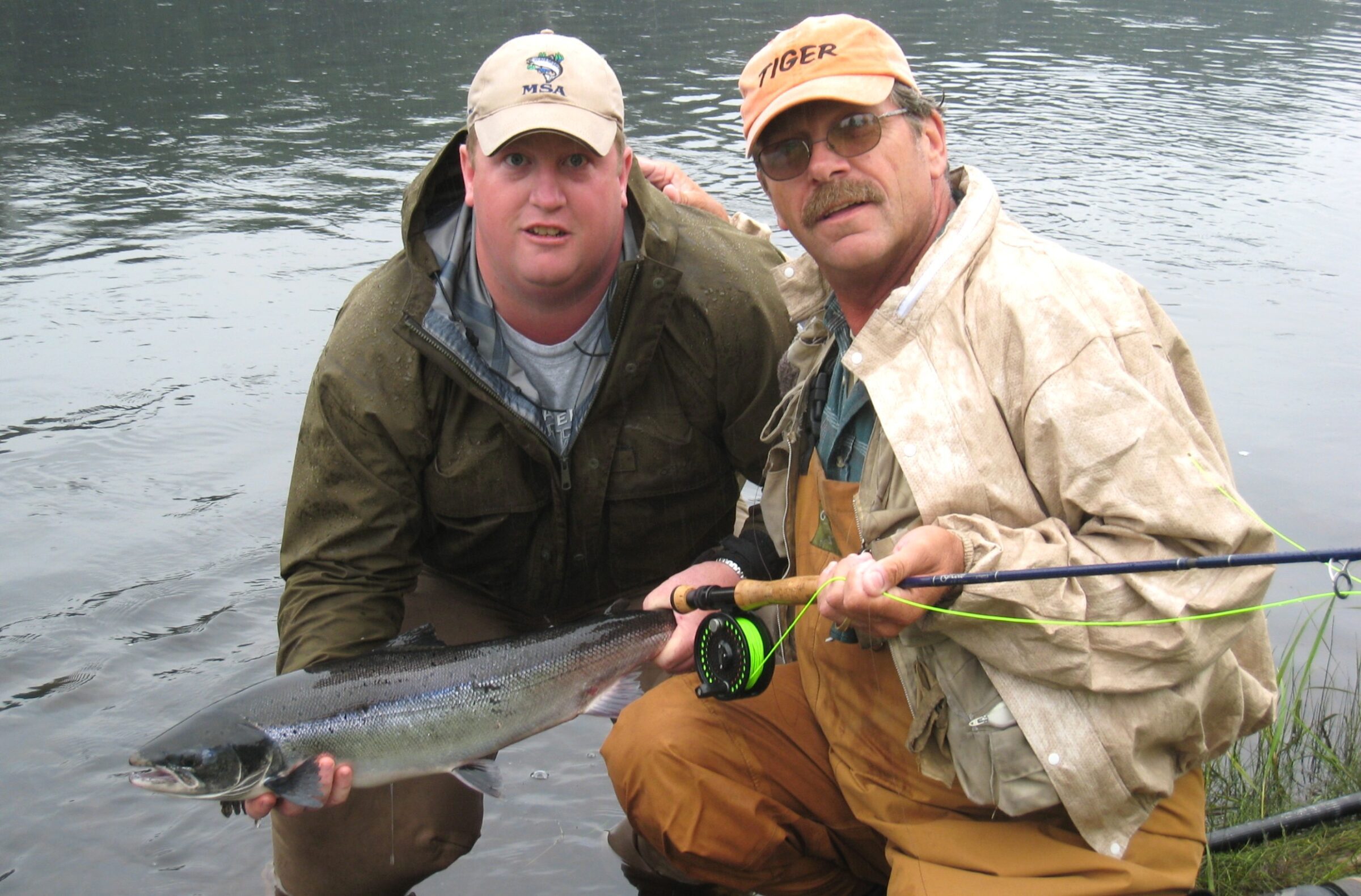
Ashley Hallihan and Steve Bellefleur with a June Miramichi salmon from 20 years ago. Campbell’s Pool was full of them that day.
We are now at that point on the calendar that many of us have been preparing for since last October. The early-run salmon are making their way up the rivers of the Miramichi system, and its time for our first serious trip to try and catch one. For me, that means heading up this Friday the 13th and coming back on around the same date in July – if it doesn’t get too hot before then. I’m getting some mixed signals on early run indicators. From both the 2024 and 2025 catch reports that I’ve heard so far, there has only been one salmon landed. That isn’t the biggest indicator since so few people are fishing, and even in the comparatively halcyon years of the early 2000s it was not unusual for the first bright salmon of the season not to be caught before mid-June. David Donahue, who has been watching the river above Doctor’s Island for more than 50 years has been seeing shad but has not yet spied a school of salmon. Last year he saw several good schools going up around June 1. The 2025 water has been high and cold for the most part, and that would make sighting a traveling school more difficult.
Byron Coughlan of Country Haven is making a special attempt this year to promote the early season salmon fishing and has some guests that have just arrived to give it a try. He is running a promo until mid-month at this link on the camp’s new website if you want to get in on this fishery. He did add that in Thursday’s fishing in Upper Blackville they did see two salmon roll. Jake Swan, last year’s early fish winner wasn’t able to get a May fish in 2025, but he also saw one on his outing at the end of the past month.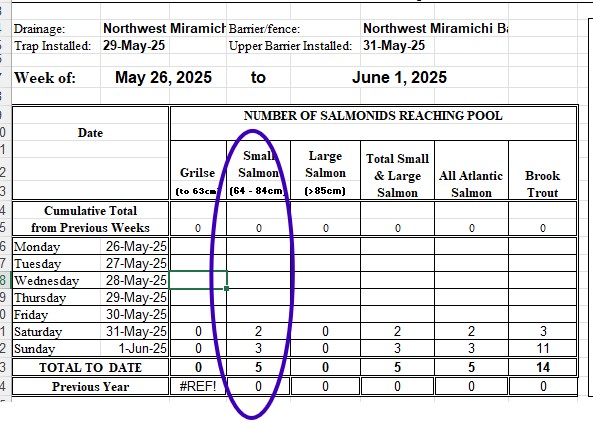 Another indicator is a report from a couple of days back that anglers from the Restigouche River Lodge had already landed 12 salmon in 2025 which is more than half of the fish that they landed during all of the 2024 season! Finally, New Brunswick DNR has barriers that are operated by the Miramichi Salmon Association on the Dungarvon and the NW Miramichi. The trap on the Northwest Miramichi became operational at noon on March 31 and still got two salmon that day and three the next on June 1. We won’t get any more info until this time next week. In 2024 it was the week of June 16 before the NWM barrier reached a total of 5 salmon. The Dungarvon started fishing at the same time, but did not catch any salmon during those two days.
Another indicator is a report from a couple of days back that anglers from the Restigouche River Lodge had already landed 12 salmon in 2025 which is more than half of the fish that they landed during all of the 2024 season! Finally, New Brunswick DNR has barriers that are operated by the Miramichi Salmon Association on the Dungarvon and the NW Miramichi. The trap on the Northwest Miramichi became operational at noon on March 31 and still got two salmon that day and three the next on June 1. We won’t get any more info until this time next week. In 2024 it was the week of June 16 before the NWM barrier reached a total of 5 salmon. The Dungarvon started fishing at the same time, but did not catch any salmon during those two days.
If you can break away for a quick trip to the Miramichi, now is the time! All of nature in New Brunswick is in full bloom, and if you get one of these big, early salmon it will be one of the finest of your life. Wilson’s, The Ledges, Ted William’s White Birch Lodge, Black Brook Salmon Club, Sutters Lodge, Country Haven, Upper Oxbow Outfitters, Mountain Channel, and doubtless several others that escape my memory can very likely accommodate you on short notice at this time of the year, and they all offer a good crack at June salmon.
The MSA’s award certificate for the first bright salmon – made from a lovely print by artist Luther Hall – goes to Scott Cormier of Riverview, New Brunswick. Scott said he fished two pools the evening of June 1 and released a beautiful salmon which he estimated at 37-inches from the second one. I’d be willing to give it a couple of inches beyond that! The fish took a #2 Undertaker. The Undertaker fly is credited to the late Warren Duncan and is similar to all of the black bear style of flies. The Undertaker uses peacock herl rather than floss for a body, and for those who can’t decide if they want a green or red butt, it has both! As one of my friends once said, “You know Brad, every fly tied with peacock herl catches fish. If the day is bright, I like a bright fly like a Silver Rat or a chenille Green Machine tied with a sparkle synthetic and a krystal flash tail, but on darker days it is hard to beat a black fly like the Undertaker, Black Rat or John Olin.
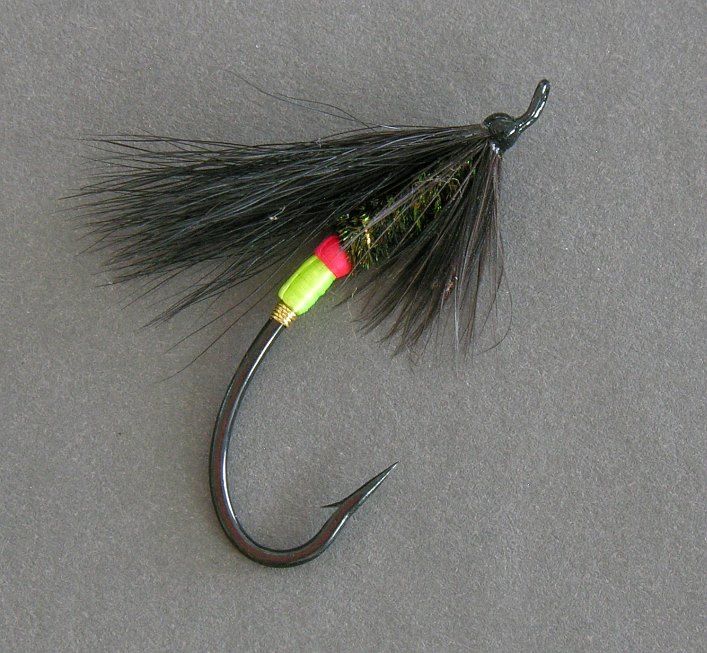
A very nicely tied and proportioned Undertaker salmon fly. Black Bear wing, black hackles throat, gold tag, chartreuse floss butt, red floss butt, peacock herl body with gold rib.
I read with interest in an aquaculture news source, that: “The FAIRR Initiative’s latest analysis determined seven of the world’s largest salmon-farming companies are facing a “critical constraint,” as overreliance on declining wild-caught sources for fishmeal and fish oil (FMFO) are hampering growth, making it imperative that producers diversify feed sources and product portfolios.” This is a huge problem for salmon that just doesn’t get enough coverage. Whether it is capelin, sand eels or krill, there are commercial harvesters scouring the globe for these organisms. Aquaculture feed is just one of the uses for these small fish. These prey species are also vital feed for salmon in the wild. Overfishing of this forage is doubtless one of the big reasons for the declining percentage of wild smolts living to return as adult salmon. In the 70s, survival of the trip from the Miramichi to Greenland and back was well above 10 percent, and while it varies year-to-year it is now well under half of that. Aquaculture has made some great strides with feeds coming from insects and plants as well as fish trimmings, but further progress is going to have to be made.

Up until last year the Bonaventure has remained very stable while the Miramichi declined precipitously.
Another interesting set of statistics was listed in the Atlantic Salmon Federation’s recent River Notes. This link takes you to a list of the Quebec Rivers where the population is monitored by actual diving counts. There are two things that come to my mind when I look at these statistics. The first is that while for a number of rivers 2024 was a poor year, many of the rivers stayed remarkably stable over recent years and a few were even up. Contrary to DFO Moncton statements salmon returns in Quebec have not suffered anything like the severe drop that the Miramichi has experienced. When the Gaspe salmon leave the mouth of the Bay of Chaleurs they are just 60 miles north of the salmon leaving Miramichi Bay. On top of that most Gaspe fish have a longer journey from their natal rivers to the open ocean than Miramichi salmon. Clearly, the difference in population declines between the Miramichi and the Gaspe Rivers is not due to the ocean journey. As we know, it is due to Miramichi striped bass eating 5 times the percentage of outgoing smolts that they did just 15 years ago.
The next thing I noticed is that in spite of the destructive management of DFO Moncton, the Miramichi salmon run, estimated last year at some 6,000 fish is still slightly greater than 50% of the 11,369 total returns from the 39 salmon rivers that the government of Quebec does counts on. This list includes the Matapedia, Cascapedia, Petite Cascapedia and Bonaventure. What an incredible resource the Miramichi still is even with its ridiculous mismanagement by DFO!
Beginning Saturday June 14, my goal is to have an Atlantic salmon fly in the Miramichi every day for a month. By the end of June we’ll also be able to add the lower Cains to our fishing repertoire. Most years the first bright salmon from the Cains comes right around June 30, and after that it can become a regular producer. During the summer almost all the Cains fish are caught in the lower 6 or 7 miles of the river. There won’t be any new salmon blogs during that time because they are just too difficult to produce on my phone. I will be posting daily Salmon Reports and photos on my website along with river conditions. These will be daily, first-hand observations as well as what I learn in regular conversations with others up and down the river. There is no alert system, but I would urge you to save this link Miramichi Atlantic Salmon Report | Brad Burns Fishing to your favorites and check on it when you have the chance if you want to stay on top of what is going on.
Save Miramichi Salmon’s lawsuit against DFO is waiting for a hearing date to answer the government’s attempts to simply have the case dismissed. This has been in the works for most of a month now, and we are hoping that we will get things moving during June. In preparation SMS’s attorneys have been working with several of the Province’s top scientists who are forming our expert witness panel.
The smolt run can now be considered over for 2025. DFO refused to grant the MSA the permits required to gather smolts for the hatchery. There was no reason given, and it simply seems inconceivable. Everyone including First Nations is very upset over this outcome. Everyone involved in this work will be trying harder between now and next spring to get full approval in advance for the stocking work, but with the attitude that some individuals at DFO Moncton clearly have about the salmon fishery the outcome is anything but certain.
In our last blog we talked some about the concept called Smolt Shepherding in the UK that is now being tried on the Miramichi being called Trap and Truck. The idea here is to get the salmon smolts around any obstacles in their path to reach the ocean. In the UK it has been used primarily to try and get around slow sections of the river filled with pike or from fish eating birds or areas where hydro schemes have placed obstacles like dams in the path of the migrating smolts. I’ve googled around on the subject quite a bit, but real answers as to what people are actually doing and what results they are seeing are hard to find. There are significant problems with smolt shepherding. One is that the proponents of it may convince themselves or others that it is a realistic alternative to really removing the obstacles to natural smolt out migration. This is especially true when you have a partner like DFO Moncton who has a clear bias against Miramichi salmon and is looking for any excuse to continue their current plan of using the river as a striped bass nursery ground for the entire Gulf of Saint Lawrence despite the effects on salmon, trout, smelts, gaspereau etc.
A return to a salmon run of the 70K numbers that we saw before the bass explosion requires that something like 1.4 million smolts make it to the ocean. This assumes a 5% marine survival. The Miramichi produced as many as 2M smolts in some years not that long ago. The returning numbers of adults are further bolstered by large, repeat spawning salmon. Given the handling required and the logistics of the trucks, smolt wheels, nets etc it seems like an impossible task to capture and truck 1M smolts, and it may well be.
Secondly, there has long been a fear that disrupting any portion of the smolts journey to the ocean can be very harmful to that fish returning to its native spawning area as an adult. The long-standing theory is called sequential imprinting. Recently, a Norwegian group published a paper that seems to prove through their own research that this is true. Here is a link to their paper Empirical support for sequential imprinting during downstream migration in Atlantic salmon (Salmo salar) smolts | Scientific Reports the abstract is worth reading. The truck and trap distances on both branches of the Miramichi are a lot longer than the 2km the paper refers to. To get by the bass you really need to drop the smolts off below Chatham. From the head of tide in both branches to Miramichi Bay is about 35Km on the NW and 45km on the SW. It is unknown how large an effect a diversion of this sort would have on the returning salmon, but it could remove any benefit we might get from outflanking the bass. When we talked about this idea inside of the MSA two years ago we came up with the concept of building a large, shallow cage on the side of the river where the smolts would be gathered. This cage would then be towed downriver at current speed. At a net downstream speed of 2kmh this would take nearly a full 24 hour period. You would need several of these cages and a fleet of boats and volunteers to accompany them downriver.
Maybe, with enough money, all these things can be worked out, but it seems unlikely. All this is a very poor alternative to simply allowing enough commercial striped bass fishing to bring the bass population down to under 100,000 spawning adults which would allow the bass, salmon, smelts and brookies to coexist in the river as they were doing quite nicely until DFO adopted their current intractable position.
I had hoped before heading north to start a letter writing campaign to the new Minister of DFO as well as the House Standing Committee that oversees DFO. It still may happen later in the week, but as of the end of last week the new committee membership had not been announced. Given everything it can probably wait until July. The last Minister did increase the FN commercial fishery quota to175K. Hopefully the new Minister and committee will put some real teeth into their instructions to DFO Moncton to bring this fishery back into balance.
Thanks for reading and stay tuned for those daily salmon reports.
Brad Burns


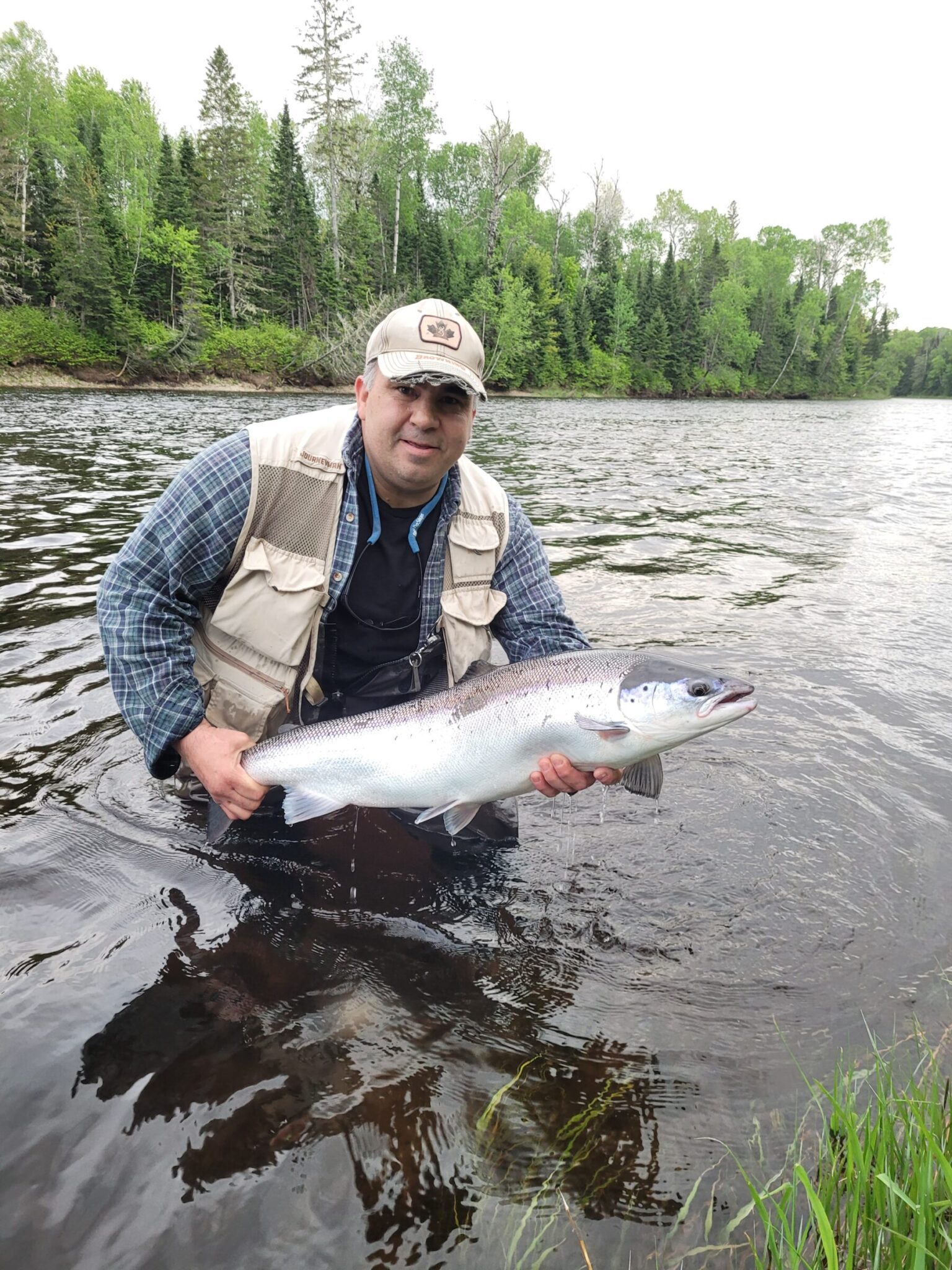
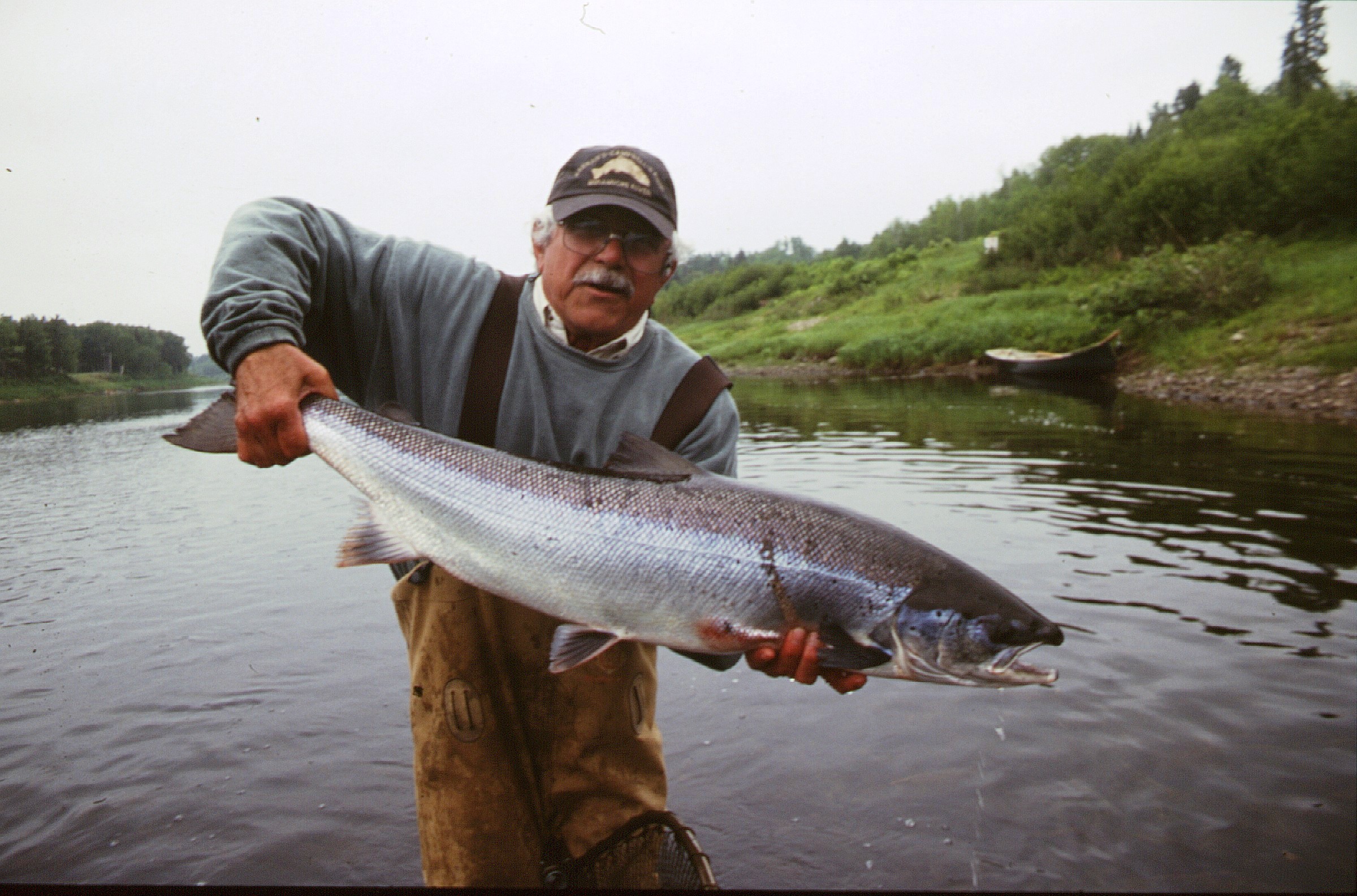
Great post as always Brad. Thanks for the info and for continuing to push for an enhancement of the salmon population.
Thanks Bob. It looks tough right now but we must keep slugging. I believe we are looking at a renegade fragment within DFO.
I am paraphrasing, but I read an article on the CBC New Brunswick website. It was suggesting that Mark Carney was considering removing department heads that were not preforming. Maybe he should start with DFO.
Amen 🙏